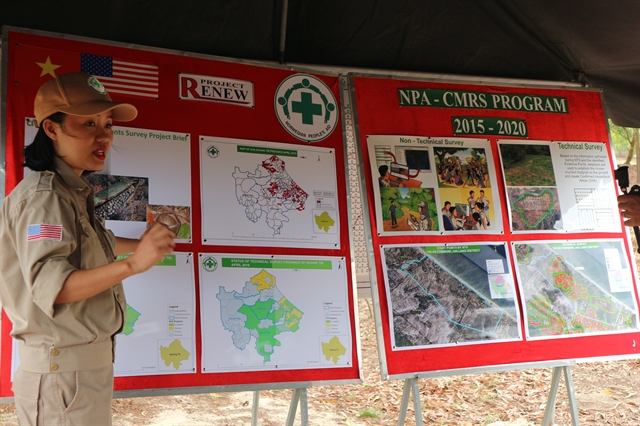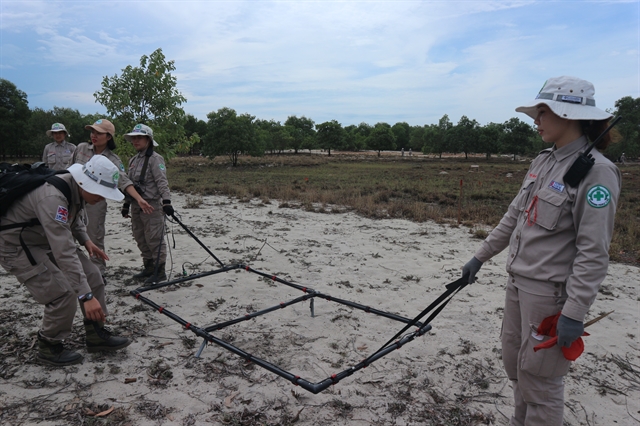
Diệu Linh explains how the clearance activities work. VNS Photo Khoa Thư
By Khoa Thư
QUẢNG TRỊ Fastening her bucket hat and carefully tucking her khaki chinos into her boots, Nguyễn Thị Thuỷ does a final check before stepping into a bare plot of sandy land.
A normal summer day in the coastal commune of Hải An, Hải Lăng District, Quảng Trị Province is scorching. Work needs to start early in the morning to avoid the unbearable heat.
In her hand, a small metal detector keeps buzzing as she swings it slowly over the land, inch by inch.
If it starts beeping, Thuỷ will mark the location with a red flag and her team members will help remove a newly-found bomb and destroy it by the end of the day.
Thuỷ, the mother of a four-year-old daughter, now leads Việt Nam’s first all-female mine clearance team, established in 2018 by Project RENEW with the support of the Norwegian People’s Aid (NPA).
Founded 18 years ago by the provincial authorities, Project RENEW has a mission to remove buried unexploded ordnance from local land using donations from the US Department of State, UK’s Department for International Development, Irish Aid and other partners.
The organisation has witnessed an increase in women joining mine clearance activities, including mapping UXO contaminated areas and destroying bombs, which used to be considered too dangerous.
Some 60 female members are working for Project RENEW on its three main fields in districts of Hướng Hoá, Triệu Phong and Hải Lăng.
Even the organisation’s operation manager is a woman.
Nguyễn Thị Diệu Linh, in her early thirties, looks like any other Vietnamese you see on the street, tiny and humble.
In fact, she has obtained essential certificates for an expert in mine action.
Under her command, 32 teams are coordinated to survey, plan and operate detonation in accordance with the International Mine Action Standards.
Linh is also in charge of building capacity for team members in land release techniques and procedure.
Starting work for RENEW as an interpreter a decade ago, Linh at that time did not know her hometown had suffered that much from war legacies.
“I was surprised and urged to make a change by becoming an operator,” she said.
Linh is lucky enough to have a supportive family. Her husband took up a mine clearing job several months after their marriage. He now works for the British-based Mines Advisory Group (MAG) as a team leader.
“My seven-year-old daughter is super proud of my job. She tells her friends that her mommy can destroy a lot of bombs,” Linh laughed.
An all-female landmine clearing team, consisting of 16 members, operate under Linh’s coordination.
Their clearance work, covering an area of 95ha, started in February and is set to finish by August this year.
So far, some 80 cluster bombs and 100 other UXO have been found and destroyed.
Nearly 3,000 locals will benefit from their efforts.
Despite being symbolic as it seems to be, the team, in Linh’s eyes, is as normal as others.
“It is actually not a manifesto for women empowerment,” she said. “There are all-male and gender-mixed teams as long as they are equipped with knowledge, skills and safety protocols in dealing with explosive ordnance. We are simply doing our jobs to make Quảng Trị safer.”

Mine clearance operators use a loop to detect UXO remaining underground. VNS Photo Khoa Thư
Five years and 165 years
“A bombardment occurs in some hours yet it takes several centuries to clean up its legacies,” said Đinh Ngọc Vũ, deputy director of Quảng Trị Mine Action Centre (QTMAC).
Until now, up to 80 per cent of the province’s area is confirmed UXO contaminated.
Since 1975, more than 8,500 people have died or been injured by UXO remaining in local soil.
Three years ago, in 2016, Ngô Thiện Khiết, Project RENEW’s team leader, was killed at the age of 45 when operating a field clearance in Hải Ba Commune, Hải Lăng District.
His teammate, Nguyễn Văn Hảo, was severely injured.
“Investigation results afterwards showed that they had strictly followed the safety protocol,” Linh said. “However, it seemed to be a delay-action bomb that somehow was activated without the team knowing.”
In the organisation’s 15 years of operation, it was the first time they suffered such a tragic loss.
The number of UXO-related casualties would have kept rising without joint efforts from local authorities and NGOs.
At the current clearance speed, from 2,300 to 2,500ha of area per year, it is estimated to take Quảng Trị 165 years to remove all bombs and mines.
For the past 23 years, US$80 million has been offered to implement landmine clearance missions in Quảng Trị yet only a small part of the province has been confirmed safe.
However, the real and achievable goal is to make it impact free from UXO by 2025.
A land release methodology called the cluster munitions remnants survey has been developed by Project RENEW which allows mapping of all confirmed hazardous areas that need comprehensive clearance.
“Usually, there are thousands of cluster munitions released from a rocket. Up to 40 per cent of bomblets were unexploded, posing danger for civilians long after the war,” said Linh.
From 2015 to 2025, QTMAC is set to clear all confirmed contaminated areas in the locality, at a depth of 30cm underground.
Instead of cleaning up every single bomb in the whole area which takes hundreds of years, they focus mainly on good management and education to ensure people’s safety.
UXO risk education and victim assistance are also integrated, aiming to equip local people with essential skills to protect themselves from explosive remnants of war and relieve post-war tragedies.
The first mine action database unit was established in 2013, offering better information among mine clearance organisations including Peace Tree Vietnam, MAG and NPA – RENEW.
A hotline was set up for all organisations which helps QTMAC coordinate clearance activities more efficiently.
From 2013, more than 4,300 UXO-related cases have been reported to the centre via this number.
“We have pulled out all the stops to make it the first province in Việt Nam impact free from UXO by 2025,” said Vũ.
“The efforts have helped to revive Quảng Trị Province from the ashes of war.” VNS
OVietnam